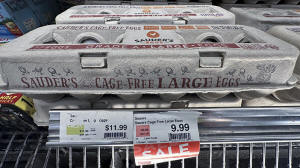Are egg producers inflating prices during the bird flu outbreak to boost
profits?
[February 28, 2025] By
JOSH FUNK
OMAHA, Neb. (AP) — Egg producers blame the bird flu outbreak for driving
prices to record highs, but critics believe giant companies are taking
advantage of their market dominance to profit handsomely at the expense
of budget-conscious egg buyers.
Advocacy groups, Democratic lawmakers and a Federal Trade Commission
member are calling for a government investigation after egg prices
spiked to a record average of $4.95 per dozen this month. The Trump
administration did unveil a plan this week to combat bird flu, but how
much that might ease egg prices — a key driver of inflation — remains to
be seen.
“Donald Trump promised to lower food prices on ‘Day One’, but with egg
prices skyrocketing out of control, he fired the workers charged with
containing bird flu. Working families need relief now," Sen. Elizabeth
Warren said in a statement.
What's behind the record egg prices?
The industry, and most experts, squarely blame bird flu. More than 166
million birds have been slaughtered to contain the virus. Some 30
million egg layers have been wiped out just since January, significantly
disrupting egg supplies. The Department of Agriculture's longstanding
policy has been to kill entire flocks anytime the virus is found on a
farm.
As a result, the number of egg layers has dropped nationwide by about
12% from before the outbreak to 292 million birds, according to a Feb. 1
USDA estimate, but another 11 million egg layers have been killed since
then, so it's likely worse. When prices spiked to $4.82 two years ago
and prompted initial calls for price gouging probes, the flock was above
300 million.

“This has nothing to do with anything other than bird flu. And I think
to suggest anything else is a misreading of the facts and the reality,”
American Egg Board President Emily Metz said.
“Our farmers are in the fight of their lives, period, full stop. And
they’re doing everything they can to keep these birds safe," Metz said.
"This is a supply challenge. Due to bird flu. Nothing else.”
Farm Action suspects monopolistic behavior. The group that lobbies on
behalf of smaller farmers, consumers and rural communities notes that
egg production is only down about 4% from last year and some 7.57
billion table eggs were produced last month, yet some consumers are
still finding egg shelves empty at their local grocery stores.
“Dominant egg corporations are blaming avian flu for the price hikes
that we’re seeing. But while the egg supply has fallen only slightly,
these companies profits have soared,” said Angela Huffman, Farm Action's
president. The Justice Department acknowledged receiving the group's
letter calling for an investigation but declined to comment on it.
The fact that a jury ruled in 2023 that major egg producers used various
means to limit the domestic supply of eggs to increase the price of
products during the 2000s only adds to the doubts about their motives
now.
[to top of second column] |

Egg cartons for sale are displayed at a grocery store, Friday, Feb.
7, 2025 in Grosse Pointe, Mich. (AP Photo/Paul Sancya, File)
 What do the numbers show?
Retail egg prices had generally remained below $2 per dozen for
years before this outbreak began. Prices have more than doubled
since then, boosting profits for egg producers even as they deal
with soaring costs.
Most of the dominant producers are privately held
companies and don't release their results. But the biggest,
Cal-Maine Foods, which supplies about 20% of the nation's eggs, is
public, and its profits increased dramatically. Cal-Maine reported a
$219 million profit in the most recent quarter when its eggs sold
for an average of $2.74 per dozen, up from just $1.2 million in the
quarter just before this outbreak began in early 2022 when its eggs
were selling for $1.37 per dozen.
Sherman Miller, Cal-Maine’s president and CEO, said in reporting the
numbers that higher market prices "have continued to rise this
fiscal year as supply levels of shell eggs have been restricted due
to recent outbreaks of highly pathogenic avian influenza.”
But he said Cal-Maine also sold significantly more eggs — some 330
million dozens, up from 288 million the year before — in the quarter
because demand is so strong and Cal-Maine has made a number of
acquisitions. Cal-Maine also suffered few outbreaks on its farms,
outside of a couple facilities in Kansas and Texas. The
Mississippi-based company didn't respond to calls from The
Associated Press.
What about production costs?
Economists and analysts say the record egg prices aren't a sure sign
of something nefarious, and short-term profits might only last until
farms get hit. Once a flock is slaughtered, it can take as long as a
year to clean a farm and raise new birds to egg-laying age. The USDA
pays farmers for every bird killed, but it doesn't cover all the
costs for farmers as they go without income.
“The consumer, I think, will probably feel like they’re getting the
rough end of the stick. But I guarantee you, the farmers that are
having to depopulate the barns, they’re having a rougher time,”
CoBank analyst Brian Earnest said.
Inflation in the costs of feed and fuel and labor have contributed
to rising egg prices, and farmers have been investing in biosecurity
measures to help keep the virus away. So production costs also
appear to be at an all-time high, according to the U.S. Bureau of
Labor Statistics' producer price index.
“This isn’t a case where they’re taking the price up to gouge the
market. It is the price is going up through auction at wholesale.
And they’re benefiting from higher prices because supplies are
tight,” University of Arkansas agricultural economist Jada Thompson
said.
All contents © copyright 2025 Associated Press. All rights reserved
 |